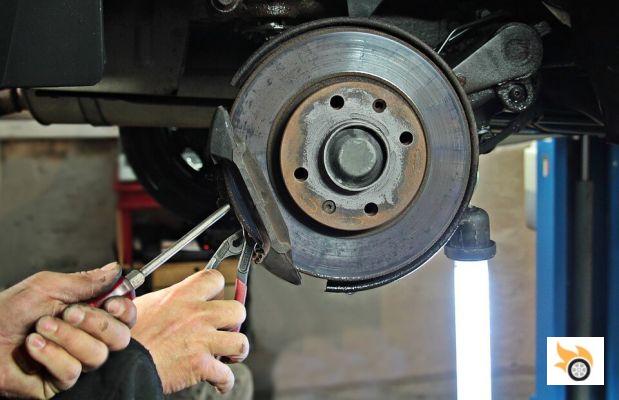
What are disc brakes?
Disc brakes are the mechanical devices responsible for braking the car safely and immediately. Thanks to the functionality of disc brakes, the braking surface available to the brake caliper increases, thus reducing the time required to stop the car.
In the past, disc brakes were optional or the prerogative of luxury cars, but now they have become standard on almost all cars and motorcycles on the road. The disc brake is a perfect complement to modern ABS, the German anti-lock braking system.
In the event of hard braking, ABS prevents the disc brakes from locking up completely, which could lead to loss of control of the car. With ABS, braking is administered gradually so that the wheels can play a little and the car doesn't become a huge bowling ball thrown out of control.
Before the introduction of disc brakes, drum brakes were mainly used, but they offered much less stopping power.
What are disc brakes like?
Disc brakes are almost always made of a steel or cast iron disc that is attached to the wheel. This disc is squeezed between two disc brake calipers. Brake pads are placed between the disc and the brake calipers.
The actual disc is very strong and should only be changed if it is damaged or after many kilometres. The component of the brake system that needs to be replaced most frequently is the brake pads. These should be replaced as soon as the symptoms of worn brake pads become apparent.
Disc brakes are therefore an essential component, but they are not enough on their own to make up the car's braking system.
How do disc brakes work?
As we have just explained, the car's disc brakes always work together with the brake calipers and brake pads. These three components are the fundamental parts of the car' s braking system along with the brake oil that circulates in the braking system circuit. To understand how disc brakes work it is essential to have a clear idea of how the braking system works.
When we press the brake pedal we create hydraulic pressure in the brake system. The oil contained in the braking system is pushed by the brakes to the other end, where the calipers and pads are placed. The oil under pressure then pushes the brake calipers, which in turn squeeze the pads against the disc brakes.
The strong friction generated by the pads against the disc brakes slows the car to a complete stop. For this reason, in addition to checking the condition of the brake pads and calipers, it is useful to always check the brake fluid level. If the level is too low, the disc brake oil should be changed to ensure that the car is safe to drive.
Now that we have understood how disc brakes work it is useful to mention how to effectively maintain disc brakes.
What to do for car brake maintenance?
Disc brakes are a fairly strong component that is difficult to damage. They mainly consist of a rigid block of steel or cast iron that must be put under heavy stress in order to be damaged or broken.
Fortunately for us, all modern cars are equipped with a brake warning light which, if it comes on, indicates problems with the braking system. The problem could be related to a brake oil leak from the brake system circuit or a damaged caliper.
The best advice to ensure effective car brake maintenance is to always have your disc brakes checked when you go to the mechanic. It only takes a good mechanic a few minutes to take a look at the disc brakes. Serious damage could be avoided if there are cracks or signs of excessive wear on the disc brake calipers.
We prefer not to recommend any kind of disc brake maintenance because if you don't know what you're doing, it could make the car dangerous to drive and compromise the braking system.
How much does it cost to change disc brakes?
Changing disc brakes is a perfectly normal operation if the car is used a lot and the number of miles driven each year exceeds 15,000. The cost of disc brakes varies greatly depending on the model of car, the brand of replacement chosen and the garage where it has gone.
A general indication is that the bigger and more expensive the car, the more expensive the disc brakes will be. This can easily reach several hundred euros. As the brake discs are already being changed, it is useful to combine changing disc brake pads to save a visit to the garage.
Our advice is to rely on a trusted independent garage where you are sure to have a wider range of spare parts and a muchlower labour cost. Labour costs should not be underestimated as they can account for over 60% of the cost of disc brake replacement.
How often do you change disc brakes?
Considering that the car is used under normal conditions, it is recommended that disc brakes are changed every 50,000 miles or twice as often as brake pads.
As a reminder, disc brake pads should be changed every 30-40,000 kilometres or when they are less than 2-3mm thick. A kilometre in the mountains, between ascents and descents, causes significantly more wear on the brake pads than on a motorway. That's why we must always keep the wear of these crucial parts for our safety under control.


























